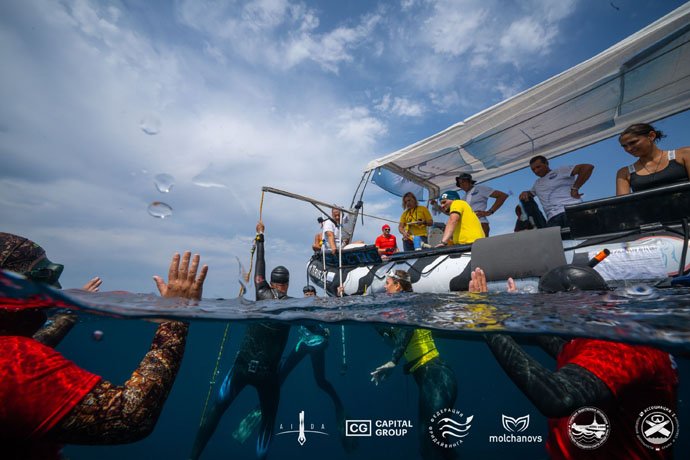Methodology for training dynamic disciplines
Today I will talk about my method of training dynamics. I will only talk about the main job. What exercises with what load to do and how to distribute this load during the season. I will speak of the extra work that I do and what it is generally advisable to do in a separate article. In the same writing, I will state some of my views on the popular methods among freedivers, which I do not share. I pretend to be scientific in none of my articles but simply state my empirical experience. Right now, I am training the DNF discipline in exactly the way that I will describe below. Let me emphasize what, in my understanding, the main work means. Most of the time, I train this way, sometimes I deviate from this concept for various reasons, and it always gives a bad result. If you do this and nothing else, you will still grow. If you do incredible amounts of everything else, but you don't do it, then you may not grow at all.

Vlad Masterskikh AIDA pool champion
So why do we need to train? To prepare yourself for competitive activity. What do we do in competitions? We dive long and far. This is what we must learn to do - dive for a long time. Why waste your time on such obvious things? I want to conclude that the training activity should imitate the competitive, either completely, or some specific phase, of course, in a more gentle mode, so that the necessary adaptation mechanisms develop. If you run 20 km as your main activity, then you are not imitating in any way what you need to do. If you swim 4 km, if you practice for 2 hours in the gym, the answer is clear again. I am not in the sense that all this is harmful and meaningless, but it can only be an auxiliary, not the main work. What about any series and modes, let's say 16 * 50? You train to recover quickly, but you don't need to. You need to swim very far once, and then you can rest for at least a week. I will also discuss CO2 training separately when I write about the utility room.
Therefore, I only believe in "long" workouts with low oxygen saturation and long dive time. You need to teach your body exactly how to use oxygen as economically as possible and also be able to work with very low oxygen content.
Now for the specifics. Let me analyze my entire technique using the example of a fictional freediver, whose personal best is 150DYN. We will assume that this is a distance already mastered, completed several times. The off-season has passed, the athlete has completed a certain amount of general physical training, and it is time to start the main training. The first thing to do is to set a goal for ourselves, to which we will strive. It is clear that the ultimate goal of any athlete is a world record, but to achieve it, you need to go through many less ambitious results. Aiming 25m above PB would be perfectly adequate. Moreover, we will try to achieve it not all year, but literally in 2-3 months. So, as the initial data, we will assume that the freediver swims 50m in 43 seconds. Now let's count a little. Now his maximum dive time is 0.43 * 3 = 2.09. We have set a goal of 175m, so the freediver will need 2.31min to swim it. This is our target dive time - 2.31. This figure we write to ourselves in our training scheme as a goal. We will structure our training so that the body can dive for so long.
To accomplish these goals, I offer three exercises. Not only the exercises themselves will be very important, but the load that you will carry out in them. Below I will describe the exercises and the goals that need to be set. After all three exercises, I will add some basic principles common to all three very important exercises.
1) 1min STA + DYN / DNF. You do one minute of static and then swim at your working pace (in this case, 0.43) dynamics. I take a horseshoe from the side and put it on after a minute. You can immediately do it in the load but put planks under you to not sink. We do the static on the surface, as usual. What is most important here is that we are doing great dynamics after this minute. You understand that if your dive time is 2.31 in this exercise, it will be easier than if you were swimming all this time. Therefore, as the goal of your training program, we choose a time of 20 seconds more. Let's say our goal here is 2.50. This is the time we will smoothly reach. By the time we reach it, we will try to swim the maximum and see if we managed to reach it or add a little more. Now you can figure out for sure that to reach 2.50 in this exercise, we will need to swim (2.50-1.00) /0.43 = 2.55 pools or 127 meters. So, our goal is 1min + 127 meters. We will do only three exercises per workout. The first exercise, like in a competition, if you don't warm up, then without warm-up, if you warm-up, then the usual warm-up and dive. The first approach is the most important one, according to which we focus on our progress. It is very important to start with the right load when you first start training. It should be such that you reach your maximum after 3-4 workouts. Since if you are already at the limit in the second workout, you will get up. An example of the first training session for our freediver would be as follows. 1.00 + 80m, the second and third exercises as per condition, leave the static for a minute, reduce the dynamics. The second and third exercises load is 85-90% of the maximum. Why did I choose the first training session 1.00 + 80? Because, in total, it will take our freediver 2.09, which is his current time in dynamics. You can even take a little less, say, 70-75m swim and see how it goes. The first workout should be easy. Then we add each next one to our swim so that after about four or five workouts, we can already swim 1.00 + 100. I am currently training DNF and at the beginning of the training cycle. An example of my workout: 1.00 + 100 (3.00), 1.00 + 74 (2.24), 1.00 + 64 (2.08). Why does this exercise work, in my opinion? It's pretty easy psychologically. No one is afraid of 1 minute of static, and the subsequent swim, especially at the beginning of the training cycle, is significantly less than your PB. You need to do a little static and moderate dynamics. Everything looks easy, but in total, it brings you to the dive time that you need to achieve.
2) Slow DYN / DNF. This exercise simulates your long dive as much as possible. The difference is that you slow down, spend less energy, and swim longer. This exercise is best for the DYN, as the speed range is very wide. Slow down to a speed of 50sec-1min. It is harder to slow down in DNF, but if you train DNF in this way, focus on the minimum number of cycles and maximum glides. Accordingly, in this exercise, we aim to reach our target dive time of 2.31. If we are swimming 50m in 1.00, we will need to swim 125m. Again, since this is easier than swimming at your own fighting pace, try to achieve a slightly higher dive time here, at least 2.45, then the distance you will need to master will be about 135m. Again, we perform only three exercises with an emphasis on the first. The first exercise with or without warm-up as in competition. An example of the first training session for our conditional freediver would be like this. Slow DYN 90m, 75m, 75m. This is easy too. We build up each subsequent one. The main task is to build up the first exercise. The rest are done according to the state. If you feel it will be difficult to add in the next workout in the first exercise, consolidate this result and add to the second or third. Why is this exercise useful, and why not dive normal highs? The fact is that it is physically and psychologically easier to swim slowly (especially if you abstract from what distance you need to swim and swim just for pleasure), respectively, in this exercise, you can much more easily reach a state close to the maximum dive, with low oxygen saturation, namely, we are striving for such a load. An example of my DNF workout - 138m for 2.56, 105 for 2.08, 75 for 1.35
3) STA + 50DYN / DNF This exercise aims to teach the head to use oxygen in the last, final phase of the dive. I think it shouldn't be done by people who train statics (on the day of this exercise, do a regular static workout), but it is extremely useful for those who, like me, train only dynamics. Its essence is that we do long static and then swim 50m with or without fins. A little more swimming is possible in the fin, let's say 65m, but not more. This exercise is back to the first one, here we will add only due to statics, and swimming is always fixed. On static, our saturation will drop quite strongly, and already against this background, we will begin to perform the dynamics. The effect of this exercise is that by the end of the swim, you will already begin to feel states of "altered consciousness." However, you will not experience any problems with acidification. The dive time in this exercise is naturally much larger than the target. The initial statics' time depends on the athlete's abilities to this particular discipline and is selected individually. Our athlete can start with, say, 2.30 + 50DYN, 2.00 + 50, 1.45 + 50 and go from there. A good goal would be the total dive time in such an exercise at 4.00. The dynamics here we swim at our working pace, which means that the target statics in the first set is 3.17 (3.17 + 0.43 = 4.00). If the static ability is much higher, the dive time will be much greater. Here our goal is to keep the drift segment of the dynamics at low saturation. An example of my DNF workout. 3.30 + 50 = 4.29 3.00 + 50 = 3.54 2.15 + 50 = 3.08
And now I want to address this issue, not from the health and safety side. A few important notes are common to all exercises. The load in each activity is large - 85-95% of the confident maximum. It is very important not to allow samba and especially blackout during training. This, again, is my empirical experience and an intuitive view of things. When you work close to the maximum but very confidently and with complete control, your body realizes that it is engaged in the activities it needs and that the load may increase, and it would be better for it to be ready. It develops adaptive mechanisms. When you get to samba, your body thinks you are attempting suicide and develops inhibitory processes to keep you from doing this in the future. I say it again, I can't prove it in any way or cite someone's dissertation, but based on my own experience, I see it this way.
Now, about how to build the training process. Let's start with how to work with these exercises. I find it optimal to do them in a row and do it three times a week. You will do each workout once a week. Each exercise is done in three stages, and that's it. You don't need more than 45 minutes to train. When training DYN and DNF at the same time, alternate them constantly. Let's say the first week you can do 1min + DYN, slow DYN, STA + DNF, and in the second 1min + DNF, slow DNF, STA + DYN. After you've done three of these hard workouts, do one light technique. The options can be different, and you can just swim DYN or DNF for fifty percent of your target time, dive only on your feet or on your hands, swim, or do light streaks. This training aims for psychological and physical relaxation, so you don't need to be too zealous. This will be your microcycle: three hard workouts, one light workout. In the next microcycle, we try to add in each exercise.
Another important point. In almost all athletes, one of the two disciplines is psychologically easier. I have this DNF for many DYNs. Since we have hard training, it will be more accessible to perform them in a psychologically lighter discipline. If, for example, it is difficult for you to swim slow DNF, then choose a flipper for this exercise. And you can swim with breaststroke after static, as a small swim is easy psychologically.
If, all the same, these pieces of training begin to put pressure on you psychologically and you do not have a similar feeling: "Oh, today I will swim dynamics after a long static, last time my dive time was as much as 4.20, and it was not difficult, I wonder how much will come out today ?!", then you can try another version of the microcycle. You do three hard workouts in the first week and three light workouts in the second. Choose your workouts in the second week arbitrarily. You can even do less than three in the water, swim, run, work with weights, in short, do any loads that will relieve stress from you, and in the next week, rest as much as possible and focus on long workouts. At the same time, keep all other work to a minimum.
Another trick, if everything was going well for you, but suddenly progress has stopped, and you feel that it is becoming too difficult to carry out your workouts, and you feel strong psychological stress, then just take a week or two of complete rest from the pool. Feel the feeling of "dry gills" and continue your workouts by rolling back a little so that it becomes easy for you to do the exercises again.
As for the load distribution over the season and mesocycles, in the off-season (usually July-August), do as much GPP as possible, run, exercise in the gym, stretch, and swim a lot, do exercises with fins. In the fall, move on to special work. Decide on a goal - to add 15-25m in dynamics and start a 2-3 month preparation mesocycle. Decide which purpose you are going for in each exercise and outline a plan to achieve it. If I had to coach someone, I tried to write down the exact numbers, with subsequent adjustments following how my ward reacted to the load. For myself, I do not paint this way, and I know what goal I go to in each exercise and write down each workout (you definitely need to do this too). I only record the results for the three sets of these exercises. And already being guided by them, I try to add. Suppose suddenly, especially at the beginning of the mesocycle, I did not calculate my strength, and the load was too high. In that case, I mark this approach in red to make the necessary adjustments at the next workout. By the end of the mesocycle, it is imperative to make test dives and see how well you managed to add. If everything worked out perfectly, we take a 1-2 week break from the pool, then set a new goal and work the same way. The initial amount of work must be reduced so that the body recovers and goes to serious distances in 3-4 weeks. Before the competition, we reduce the amount of work, and we begin to recover. In 2-3 weeks, we start to dive at the maximum, then a week of complete rest before the start.
What other reasons can I make in favor of my system? You know where you are all the time. If your PB in DYN was 150m and now in training, your slow DYN 140m is very confident, then you already realize that you can dive further, and everything is fine. Again, the mesocycle is designed for only 2-3 months, and if something does not work, there is time to reconsider the approach. A very big mistake is made by freedivers who do some gigantic amounts of work, swim 3-4 km per workout, dive crazy series and start trying long distances only 2-3 weeks before the start. The worst thing is that they also start once a year, and there are some like that among strong athletes. And here, a situation often arises when an athlete thinks that he was doing cool things during training, dives, and does not add anything compared to the previous year. And this means that the year of life is flushed down the toilet. Do not make such mistakes. Every two or three months, you have to see if there is any progress and make adjustments. With the current level of our athletes, adding 5-10 meters per year means never reaching the world level.
A few more words on the number of starts per year. In my opinion, it is optimal - these are three starts distributed in time during the season. Moreover, the first can be done at the beginning of the season, right in the middle of your mesocycle, without much preparation. We have already prepared substantively for the main starts. It is highly undesirable to start with an interval of fewer than two months. In 2-3 months, you can recover and carry out a new mesocycle and increase the result. But in my opinion, the worst option is one start per year. You can get sick, overdo it, or improperly distribute the training process, which will result in either a bad result or lack thereof. You will need to wait an entire year to correct mistakes. Again, psychological stress, from the fact that you have only one chance to show all your achievements, is very high and has a negative effect.
I tried to describe everything in detail, there will be more posts about the backroom, my attitude to the series, and how to deal with acidification, but these are all details, here I set out the main idea. My concept is quite different from those generally accepted in our country. In general, if your workouts work well (in my understanding, the criterion is an increase of more than 20m per year), do not change anything and do everything as usual. But if you are stuck, you have some material to think about. If you want to try my method and have any questions, or you write a program and want to make sure that you understand the concept correctly, do not hesitate to contact me. I will definitely answer. Of course, it is very difficult to draw up a training program from start to finish if it is done conscientiously and requires constant contact with an athlete. Still, I'm ready to give general recommendations, correct something, and suggest how to deal with certain difficulties during training.




